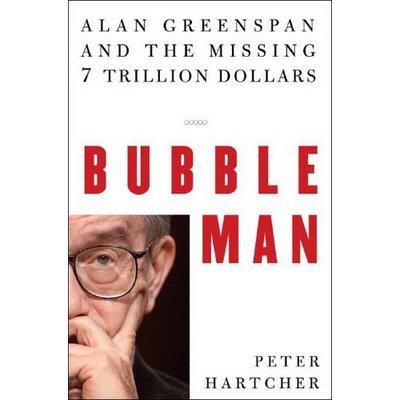Thursday, June 01, 2006
Alan Greenspan Demoted to Equity `Bubble Man' From Fed Maestro

Alan Greenspan Demoted to Equity `Bubble Man' From Fed Maestro
June 1 (Bloomberg) -- The Bond Market Association announced last month that it's creating an annual ``Alan Greenspan Award for Market Leadership.'' According to author Peter Hartcher, Greenspan himself would be ineligible on grounds of incompetence.
In ``Bubble Man: Alan Greenspan and the Missing 7 Trillion Dollars,'' Hartcher accuses the former Federal Reserve chairman of dereliction of duty for allowing a U.S. stock-market bubble to balloon and then burst on his watch.
Hartcher sets out to convince the reader that Greenspan, the man dubbed ``Maestro'' in Bob Woodward's biography, could and should have tried to restrain surging equity prices. Much to my surprise, Hartcher succeeds.
Like a skilled prosecutor, he uses the words and deeds of the accused to make the charge stick. As a former Washington bureau chief for the Australian Financial Review, Hartcher brings an outsider's perspective to the capital's machinations. While his book lacks the historical perspective of John Kenneth Galbraith's ``The Great Crash 1929,'' it rattles along at a cracking pace, like a well-constructed documentary.
Greenspan has stated publicly that central banks shouldn't meddle with asset prices. Hartcher uses Fed meeting records to show that Greenspan started with a different opinion, and mulled increasing the amount of money investors must set aside to cover stock-market bets. The central charge is guilt by omission: had Greenspan done more to restrain the stock market, the trashing of retirement savings in the collapse would have been limited.
Frothy Top
On Sept. 24, 1996, Fed Governor Lawrence Lindsey suggested the U.S. central bank might consider trying to rein in stocks ``while the bubble still resembles surface froth.'' The previous day, the Standard & Poor's 500 Index had closed at 687 points for a gain of 18 percent in 12 months.
``I recognize that there is a stock-market bubble problem at this point,'' Greenspan replied, according to the minutes. His attempt at a solution came on Dec. 5, 1996, by which time the S&P had climbed a further 8.3 percent to 744 points.
In a 5,000-word address that day on ``The Challenge of Central Banking in a Democratic Society,'' Greenspan raised the possibility that ``irrational exuberance has unduly escalated asset values.'' Greenspan, Hartcher says, was testing the waters in an attempt to expand the scope of monetary policy to cover asset-price inflation.
``All his power, his skill and, crucially, his courage were about to be put to the test,'' Hartcher writes. ``This was Greenspan at his best. He was alert to a new danger, and he was about to demonstrate intellectual and institutional leadership in confronting it.'' He failed the test, the author argues.
Seed of Doubt
Here's where the groundwork laid by Hartcher pays off. In the first half of the book, he shows how Greenspan neutered the Fed's monetary-policy meetings, holding pre-meetings to preempt dissent among the governors. By drafting the Fed statement before the meeting was held, ``Greenspan had kept the trappings of due process but gutted their substance,'' the author says.
He then plants a fertile seed of doubt about Greenspan's willingness to put politics before principles, suggesting that Fed support for President George W. Bush's deficit-swelling tax cuts in 2001 and 2003 was part of ``an understanding,'' with Bush agreeing not to comment on Fed policy moves.
Next, Hartcher cites figures showing Greenspan held an average 3.9 meetings a week with Congress members in 2004, up from 3.3 in 2003 and 1.8 in 1996. From 1996 to 2000, Greenspan had about one meeting a month at the White House; in 2001, he visited 37 times, and by 2004 he was there once a week.
`Poisonous' Politics
So the case for the prosecution is well grounded by the time Hartcher presents the ``irrational exuberance'' speech as Exhibit A. The ``poisonous'' political response to that remark dissuaded Greenspan from following words with deeds, he argues.
``Greenspan had set out on a course of what he judged to be a wise policy, but then had allowed himself to be intimidated by the political difficulty involved,'' Hartcher writes. ``He changed direction completely, and clasped the whole madness to his aged breast with the zeal of a convert.''
The author also offers a pointer to the future. ``Asset price inflation is the new inflation for central banks, one that is becoming more virulent, not less, and one for which there is not yet an agreed treatment,'' he writes. The conclusions to that argument among the world's guardians of monetary policy may yet provide Hartcher with another book.
``Bubble Man'' is published by Norton (211 pages, $24.95).
(Mark Gilbert is a Bloomberg News columnist. The opinions expressed are his own.)

